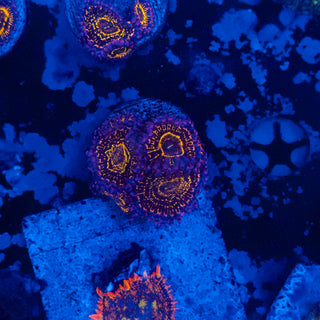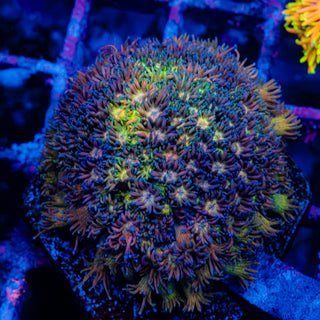🌈 Why No Two Tanks Look the Same
Stop chasing someone else’s colors. Every system tells its own story.
Every reefer has seen it — you buy a coral that looked wild online, drop it in your tank, and two weeks later it looks completely different. Not worse, not fake — just different.
Here’s the truth: no two systems are the same. Lighting, flow, nutrients, photo setups, even the depth of your coral rack — they all change how coral pigments react and how your eyes read color. That’s not hype. That’s biology.
The Variables Nobody Talks About
Everyone wants the “exact recipe.” The same color, the same glow, the same shot they saw on Instagram. But here’s reality — to make two tanks look identical, you’d have to perfectly match every single variable that affects coral pigmentation and tissue health:
Core parameters: Alkalinity, calcium, magnesium, nitrate, phosphate, salinity, temperature, pH, and CO₂ balance — the foundation of stability and calcification.
Lighting and environment: PAR levels, Kelvin temperature, spectral output, photoperiod length, water depth, surface agitation, glass thickness, and even shadow angles from your rockwork.
Flow dynamics: Randomness, velocity, turbulence, direction, detritus suspension, and coral placement relative to powerheads — all shaping polyp behavior and nutrient exchange.
Trace and minor elements: Every single one matters — potassium, strontium, iodine, iron, manganese, zinc, copper, molybdenum, boron, vanadium, cobalt, chromium, nickel, selenium, tin, titanium, lithium, rubidium, barium, fluorine, and the rest of the periodic soup that fuels enzyme activity and pigment formation.
Biological variables: Bacterial strains, dissolved organics, amino acid levels, fatty acids, DOC, humic substances, and microfauna balance — the invisible side of coral metabolism.
External influences: Salt batch chemistry, RO/DI purity, dosing method accuracy, evaporation rate, and even the brand of test kits used to measure all this chaos.
Every one of those variables plays a role. Miss one, and your coral will still look healthy — but it’ll express differently. That’s the beauty and the curse of reefing: it’s not plug-and-play, it’s cause and effect.
So when people ask why their piece doesn’t look like the photo, this is why. It’s not bad lighting or bad luck — it’s chemistry, biology, and chaos pretending to be stable. You don’t copy someone’s system; you tune yours until it glows.
Lighting Changes Everything
Lighting is the biggest variable. PAR levels, Kelvin, and brand all affect how a coral develops and displays pigment. Radions, AIs, Kessils, Orpheks — they all throw different spectrums and blend differently in water.
The coral doesn’t care what fixture you use; it reacts to how much usable light it actually gets. Two people can run the same coral under “AB+” and end up with completely different results. Your tank’s depth, glass thickness, and even your scape’s shadowing all shift what hits that frag.
Flow and Depth Matter
Flow isn’t just about movement — it drives coral health. Strong, random flow promotes thicker tissue and better polyp extension, while low flow zones can mute color over time.
Depth changes the game too. Deeper racks filter out red and yellow wavelengths, leaving more blue light. That alone can swing an SPS from pastel to neon or vice versa.
The Hard Truth About Lighting
Let’s just be real — ALL SPS LOOK LIKE SHIT UNDER PURE BLUE OR WHITE LIGHT without an orange lens. Unless they’re green. Greens don’t care. They always pop. Everything else? Flat, washed out, and lifeless until the spectrum hits right.
That’s not a photography trick — that’s physics. Corals don’t actually glow; they fluoresce under certain wavelengths. So when you shoot or view under actinics without a lens, all those reds, pinks, and purples get swallowed by the blue.
If you want to see what your coral really looks like, add the filter. You’re not “faking” it — you’re correcting it. Otherwise, you’re just staring into UV soup and wondering why your $200 frag looks like a sad stick.
Photography Plays Tricks
The camera doesn’t see what your eyes see. White balance, exposure, and filters can completely rewrite what the coral looks like. A shot under heavy actinics will glow like nuclear candy — same piece under whites might look muted, even though the coral itself hasn’t changed one bit.
Phones, DSLRs, and lenses all interpret color differently. What looks “fire” on Instagram might look normal under daylight — and that’s okay. Don’t chase pixels. Chase growth.
System Chemistry
Every tank’s chemistry writes a different story. Nutrient balance, trace elements, and stability all shift how pigments express. One reefer runs low nutrients and gets soft pastels. Another runs higher PO₄ and NO₃ and gets deep saturation. Neither is wrong — they’re just different systems doing what works for them.
That’s why comparing your color to someone else’s is a dead-end. You don’t have their water, their light, or their hands. You’ve got yours.
Adjustment Takes Time
Corals need time to settle in before they show their real colors. Even in ideal systems, it usually takes up to two weeks for an SPS to adjust and start coloring up. Sometimes longer if it’s a fresh import or wild piece.
Super aquacultured corals adapt faster — they’re used to captivity and stable parameters — but most frags still go through an adjustment phase. That’s not a vendor issue; that’s coral biology. Give them time to sync with your system before you judge the color.
The Takeaway
Stop chasing other people’s photos. Start learning your tank’s language. The best reefs aren’t copies — they’re tuned systems that play to their strengths.
Corals don’t lie. They just tell the truth in different colors.












